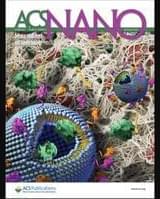Bacterial biofilm formation is a huge problem in industry and medicine. Therefore, the discovery of anti-biofilm agents may hold great promise. Biofilm formation is usually a consequence of bacterial cell–cell communication, a process called quorum sensing (QS). CeO2 nanocrystals (NCs) have been established as haloperoxidase (HPO) mimics and ecologically beneficial biofilm inhibitors. They were suggested to interfere with QS, a mechanism termed quorum quenching (QQ), but their molecular mechanism remained elusive. We show that CeO2 NCs are effective QQ agents, inactivating QS signals by bromination. Catalytic bromination of 3-oxo-C12-AHL a QS signaling compound used by Pseudomonas aeruginosa, was detected in the presence of CeO2 NCs, bromide ions, and hydrogen peroxide. Brominated acyl-homoserine lactones (AHLs) no longer act as QS signals but were not detected in the bacterial cultures.
